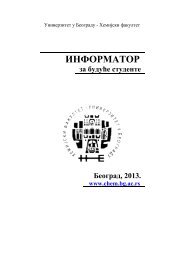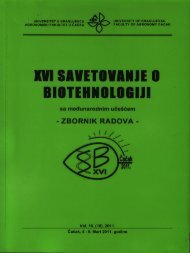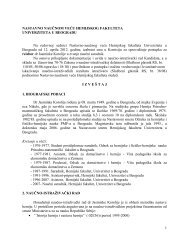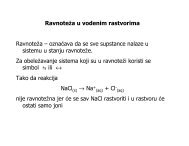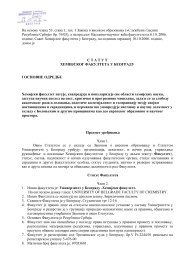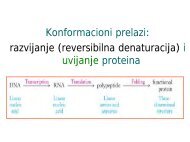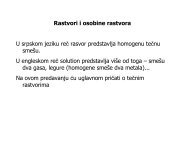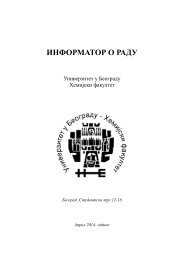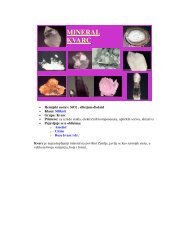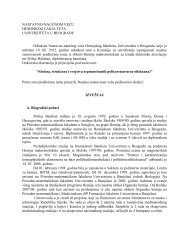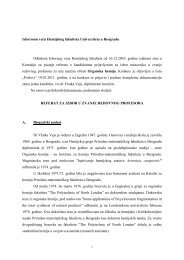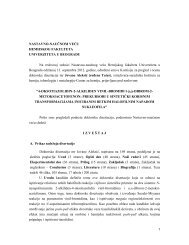The 3rd AAPG/SEG/EAGE International Geosciences Student ...
The 3rd AAPG/SEG/EAGE International Geosciences Student ...
The 3rd AAPG/SEG/EAGE International Geosciences Student ...
Create successful ePaper yourself
Turn your PDF publications into a flip-book with our unique Google optimized e-Paper software.
<strong>The</strong> <strong>3rd</strong> <strong>AAPG</strong>/<strong>SEG</strong>/<strong>EAGE</strong> <strong>International</strong><strong>Geosciences</strong> <strong>Student</strong> Conference29-31 May 2012, Belgrade, Serbia
PROCEEDINGS<strong>The</strong> <strong>3rd</strong> <strong>AAPG</strong>/<strong>SEG</strong>/<strong>EAGE</strong> <strong>International</strong> <strong>Geosciences</strong> <strong>Student</strong>ConferenceEditor:Saša Smiljanić, Association of Geophysicists and Environmentalists of Serbia (AGES)Reviewers:Snežana Komatina-Petrović, SerbiaMilovan Urošević, AustraliaAlfred Frasheri, AlbaniaAldo Vesnaver, ItalyMiomir Komatina, SerbiaBiserka Dimiškovska, FYRMEldar Husejnagić, Bosnia and HerzegovinaEditorial Board:Miomir KomatinaSvetlana Lazić-FišterTomislav JovanovićPublisher: Association of Geophysicists and Environmentalists of Serbia (AGES)For Publisher: Snežana Komatina-Petrović, Association of Geophysicists andEnvironmentalists of Serbia (AGES)Printed by: PROOF, BelgradeCopies: 500ISBNAll papers in the Proceedings are reviewed
<strong>The</strong> Proceedings are published with the financial support of the Ministryof Science and Education of SerbiaORGANIZERSAssociation of Geophysicists and Environmentalists of Serbia (AGES)Conference Executive CommitteeSaša Smiljanić, PresidentMarko Vanić, Vice-PresidentUna Petrović, Vice-PresidentSnežana Komatina-Petrović, MemberMilovan Urošević, MemberAldo Vesnaver, Vice-PresidentMilan Dimkić, MemberBiserka Dimiškovska, Scientific Secretary<strong>International</strong> Advisory CommitteeSnežana Komatina-Petrović- AGES PresidentIsabelle Czernichowski-Lauriol - CO 2GeoNet PresidentNick Riley - CGS Europe ChairNiels Poulsen - EneRG PresidentTechnical ProgramAleksei Schevchenko, ChairmanEugenio Loinger, MemberAlfred Frasheri, MemberGeorgi Georgiev, MemberNecati Gulunay, MemberEldar Husejnagić, MemberKoya Suto, MemberSlobodan Stanić, Member
DELOVNI LISTNAVODILA ZA IZDELAVO OSEBNE IZKAZNICE SADJA/ZELENJAVE1. Izdelaj osebno izkaznico sadeža oz. zelenjave.V literaturi poišči čim več podatkov o njem. Kaj vse ga sestavlja?2. Kaj vse lahko pripraviš iz njega? Kje ga lahko uporabiš?3. Zakaj je pomembno, da ga uživaš?4. Ali boš to sadje/zelenjavo v prihodnje užival/-a večkrat?PREPRIČAJ SOŠOLCE, DA JE TVOJ SADEŽ (ALI ZELENJAVA)NAJBOLJŠI (NAJBOLJŠA)!JABOLKOVitamini:Minerali:Izdelki:
CONTENTSPhysics of the Earth’s InteriorAdriana STOICA*, Alexandra OTELEANUMineral assemblage and depositional environment analysis of alluvial sedimentsonAmpoi River, RomaniaÁgnes KirályNew Interpretation of the Old ΔZ Magnetic Anomaly Map of HungaryAnna SkorkinaCorrection assessment to obtain quality factor for Perm region seismological dataIon Francovschi<strong>The</strong> geology and tectonics of the superior basin of the Casin River valley (EasternCarpathians, Romania)Gerea AlexandraA study on global recordings of P3KP slowness and amplitude valuesAndreea OpreaStudy of the fluid inclusions from quartz eclogite from the Costesti Valley –Capatanii MountainsBlerta Dyrmishi ;* Egla LucaSeismic risk assessment through strong ground motion and vulnerabilityAndrei Străchinaru*, Andrei Panaiotu, Diana Ciobanete andCristian G. PanaiotuPaleomagnetic studies in the northern part of Gurghiu Mountains: age and tectonicimplicationsMałgorzata DrwiłaGeodynamic processes which affect Earth’s rotation and position of Earth’sfigure axisMaria Placinta*, Bogdan Buioc, Izabela MarisProvenance analysis on Sard conglomerates, Transylvanian Basin, RomaniaMuhammad Cipta Suhada* and Dimmas RamadhanGeophysical magnetic method for detecting intrusion body and lithology complex inParang Mountain, Karangsambung, Central Java, Indonesia
Antoniy Kisyov, Vladimir KunchevTsunami hazard in the Black SeaDimitar Kirov, Boyko Ranguelov<strong>The</strong> 3th cruise with the research ship “Mare Nigrum” which is a little part of theproject MARINEGEOHAZARDSMartin Hristov ToshevAn approach for evaluation the seismic effects on urban area: Case study forSofia cityStefan Prekovic*, Bojan D. Petrovic, Uros LukicGeomathematical analysis of seismic data for the City of Kraljevo after the 2010Kraljevo earthquakeNear-surface geophysicsJakub CapałaDetermining associations between certain petrophysical properties usingacoustic, density and neutron logs, based on Carpathian Foredeep’s MioceneseriesRicki*, Dyna Mariana, Muhammad Dhafit MuhsinDetermining lithological contact of limestone and claystone usinggeophysical methods: case study Jatibungkus Hill, Karangsambung, CentralJava, IndonesiaAttila Balázs*, Ágnes Király, Ágnes BőgérEvidence of magmatic bodies under the Lake BalatonCezar Iacob*, Razvan Orza, Andreea HulpoiIdentifying oxidation and reduction zones using geoelectrical investigations ontailing pondsDragos Mitrica, Oancea Georgiana-CristinaMagnetic proprieties recorded in the detrital sediments from “Pestera cu ApadinValea Lesului” caveAndreea Mârza*, Alina Mărăşescu, Răzvan OrzaArchaeological investigations by means of GPR techniques at Orgame/Argamum, RomaniaG. Trandafir*, C. IacobGeoelectrical investigation of the Orgame/Argamum archaeological site nearJurilovca, RomaniaRazvan Orza*, Ionelia Panea, Cezar Iacob
Integrating near surface geophysical methods for characterizing Quaternaryphreatic aquifer systemBojan Brodić*, Ilija Vasiljević, Nikola Sretenović<strong>The</strong> usage of multiple geoelectrical attributes and a pseudo 3D interpretationof the cross-square array data in a clastic deposition systemDwipaningtyas*, Bestman Winner Simamora, and Dian EnggeliaPseudo 3D gravity modeling to determine intrusion contact of Parang Area,Karangsambung, Central Java, IndonesiaA.V. Lazăr*, A.D. Balahură, G.V. UngureanuSidescan Sonar scanning and seabed classification on Vama Veche - 2 Maiand Sfântu Gheorghe NATURA 2000 sitesBoyko Ranguelov, Mariya Velikova*, Iveta KarabelyovaGeophysical measurements in situ (radioactivity and magnetic susceptibility) of therocks around BAB – Livingstone Island (South Shetlands – Antarctica)Bartosz Gierlach*, Julia SzudzinskaGPR method in archaeological research of church in Witonia (Łódz district,centralPoland) Bartosz Gierlach*, Julia Szudzinska*Ivaylo Papratilov*, Christian TzankovComparing the accuracy and speed of calculation of two vertical rectangular prisms inMATLAB environment*Obinna Nzekwe, Anja Tögl, Terence NgoleIntegrated geophysical investigation of the near-surface hydrogeologicalcharacteristics: A case study of a pasture field in Malchen, SE Darmstadt,GermanyAlexander Tsvetkov, Atanas Kisyov, Lyubomira Trendafilova, ValentinaIlievaEffectiveness of the geophysical researches applying VLF method and threeelectrodearray DC profiling in deposit “Rozino”, East RhodopesYakymchuk N.A., Levashov S.P., Korchagin I.N., Bozhezha D.N.,Shyrkov B.I.*Assessments of the ore-bearing prospects by method of remote sensing dataprocessing and interpretationLoya Jirga, Stephanie Saing*, Ongky ElismanApplication of Geophysics Methods in Mining ExplorationStoiko Hristov*, Atanas Kisyov, Christian TzankovA georadar survey combined with permittivity determination in marbles
Geo-EnergyGigih Helma W*, Herlan Dharmawan, Muhammad Hilmi H, AgusDwi P, Danastri Kusuma N, Nike Sri S and Ahmad AliCSAMT Investigation and Its Analysis Using 1D, 2D and 3D Approach inGeothermal Manifestation Area, Parangwedang, Yogyakarta, IndonesiaGita Septianti Srikandi, Nurcahyo Indro Basuki, Niniek Rina Herdianita,Lutfi Baiti, Tsania Ozza*Geothermal energy potential in volcanic arc system: Mount Tampomas inWest Java Province, IndonesiaLotanna Ufondu<strong>The</strong> Geothermal Potentials of the Middle and Lower Benue TroughSaša SmiljanićModelling of Geothermal Systems in VojvodinaAgata BejnarowiczPetrographic analysis of the limestone reefs of upper Permian (Zechstein)on the example of selected natural gas deposits (Wolsztyn Rigde, Poland)Yuriy IvanovNumerical modeling of EM logging signals in sand-shale reservoir using claydistribution models for study of low-resistivity oil reservoirsRudiny Hansen*, D. Ahmad Ramdani, Candra A. Pradana, LaurenciusHamonanganSpectral decomposition and maximum negative amplitude attribute formapping thin sandstone reservoirs – a case study from the West Java BasinElvira Razyapova*, Vladislav SudakovSelection of control criteria for development of oil deposits with their waterflooding based on reservoir modellingEvdokimov StanislavNew methods in oil-field developmentMiroslava Zubalova*, Peter KolarovicConversion of gas reservoir to underground gas storage (UGS) – 3D structuralAnd petrophysical modelRuslan Gilmutdinov*, Rinat Gabdrakhmanov, Nouria Nourgalieva,Fidaniya NosovaUnique Yaregskoe oilfield - geological aspects and features of petrominedevelopment system
Matko PatekarInfluence of geothermal gradient assessment methodology on the regional estimates ofCO2 storage capacityJovanovic GoranaEnvironment and energy - Focus on the Western BalkansEnvironmental issuesJonas Küster*, Kai Wünnemann, Georg Kaufmann3D gravity model of the Nördlinger RiesNenad Marić*, Stanko Sorajić, Jelena Zarić, Marko VanićImprovement of the research methodology of groundwater contaminationby petroleum hydrocarbons in SerbiaPiotr Wójtowicz*, Marcin Siepak, Jakub Ciążela, Ewa Grabowska,Paulina Kobyłecka, Ewelina Krzyżak, Marta Prokopyk, Justyna Rychły,Radosław Wilczkowiak, Piotr Zakrzewski, Daniel ZimnyVariability in concentrations of metals in soils near outlet roads in Poznań(Poland)Marijana Krupniković, Nevena AndrićPotentially toxic trace elements in coal, slag and fly ash from the Kostolacthermal power plantLemenkova P. (*), Forbes B.C., Kumpula T.ILWIS GIS for monitoring landscapes in tundra ecosystems: Yamal Peninsula,RussiaMarina Ravilic*, Milica Stefanovic, Jelena DrobacEnvironment and ash disposalsMarius-Florin Paslaru*, Teodora-Arina TanasieDetermining optimal areas for wind farm construction through GIS analysisBartosz SilczakGroundwater flow model of Ostrow Wielkopolski area (Poland)Jovana RadosavljevicWater quality difference in karst and fissure aquifer in Petnica areaMihailo SevicConcentration of arsenic, manganese, zinc and iron in public water wells inZrenjanin
Filip Bielicki*, Adam Czuchrowski, Natalia Hoska, Ewelina Krzyżak,Małgorzata Kurkiewicz, Marcin Siepak, Piotr WójtowiczMetal concentrations in flood sediments of the Warta River valley in thearea of Poznań (Poland)Jovana Milosavljevic*, Maja Todorovic, Marina CukPesticides in geoenvironment and influential factors on healthMaja Todorović*, Marina Ćuk, Jovana MilosavljevićNitrates in groundwater of SerbiaMarina Cuk*, Maja Todorovic, Jovana MilosavljevicArsenic occurrence in groundwater of Southern part of Pannonian basin(Serbia)Milica Č. SkopljakDissolved lithium in drinking water affects suicide rates in Republic of SerbiaAndreea-Alexandra Hulpoi<strong>The</strong> application of quantitative methods in landslide susceptibility assessment.A case study in Romania (Satu Mare County)Sonez ShekharZero tolerance towards discharge today: way to a greener tomorrowBjegovic Darko*, Aleksic Vladan<strong>The</strong> Impact of Climate Change on Water Resources (Example of Sava River)Kristina Kostić, Sonja Milićević, Milica Bekčić , Jovana Takić, LazarŽivadinović, Dragana Milićević, Slavica MrfatBiodiversity of Lake ĆelijeMiloš Milošević, Milena RadojčićSerbian Geo-inheritance – AvalaNikoleta VlaškovićGeoheritage in Serbia - Devil's TownJelena CvetkovićCaves of SerbiaAndrej BožovićBeljanica Hot SpringsUna MatićDeliblato SandsMarija Preradović<strong>The</strong> Tara Mountain
Improvement of the research methodology of groundwater contamination by petroleumhydrocarbons in SerbiaNenad Marić*, Stanko Sorajić, Jelena Zarić, Marko VanićSummaryDuring the last 30 years the Republic of Serbia has had several major accidents with petroleumhydrocarbons which have caused significant negative effects on groundwater and geologic media.Data collected at locations of mentioned accidents are used this paper in order to present themethodology which was applied in this type of research in Serbia. Beside mentioned methodology asit basis, particular tendency of this paper is to provide insight into the basics of bioremediation andnatural attenuation as emerging approaches for mentioned issues. <strong>The</strong> application of these approachesin groundwater quality improvement in Serbia is at the beginning. This paper aims to emphasize thenecessity of research methodology improvement in order that hydrogeology can provide fullcontribution to the application of bioremediation methods in field conditions.IntroductionGroundwater represents about 98% of the available fresh water of the planet (Alvarez and Illman,2006). Contribution of groundwater in the public water supply of the most European countries isdominant. Similarly to these countries, about 80% of the public water supply of the Serbia comesfrom groundwater (Polomcic et al., 2011). Considering the extensive use of petroleum hydrocarbons,this group of compounds is among the most common groundwater contaminants. According toVujasinovic and Matic (1995) on the teritory of the Republic of Serbia several major accidents hashappened which have caused contamination of groundwater and geologic media by petroleumderivates, see black points in Figure 1. As the basis of this paper, united results of research performedat mentioned locations are presented, in order to provide insight into applied methodology.On the other hand, during the last 20 years research of the environmental impacts of petroleumhydrocarbons have been significantly improved. This improvement has caused better understanding ofthe behavior of these compounds in field conditions, as a necessary precondition for the selection ofappropriate remediation methods. All this has resulted in the necessity to extend approach formentioned environmental issues, from entirely hydrogeological used so far, to much more complexinterdisciplinary approach. In this context basics of in situ bioremediation methods and theirsignificance for the preservation of groundwater quality are given.Figure 1. Locations of major accidents with petroleum derivates in Serbia(Vujasinovic and Matic, 1995)3 rd <strong>International</strong> <strong>Geosciences</strong> <strong>Student</strong> Conference29-31 May 2012, Belgrade
Research of groundwater contamination by petroleum hydrocarbons in SerbiaData – MethodologyDuring the last 30 years the Republic of Serbia has had several major accidents which have causedcontamination of groundwater and geologic media by petroleum hydrocarbons. Data collected at thesesites are used in this paper in order to provide insight into methodology which was applied. <strong>The</strong>quantities of contaminants in mentioned accidents were significantly different, from about 45 tones inMakis, up to 540 tones in Vitanovac. <strong>The</strong> common thing for all these accidents is that they havesignificantly endangered groundwater and sediments in the area around the location of accident. Thisis a consequence of the construction of infrastructure facilities without considering of their impact onthe environment and providing adequate conditions for its protection. <strong>The</strong> most obvious example forthis is the construction of the freight station in the sanitary protection zone of Belgrade source inMakis.Works performed in order to reduce negative effects of these accidents could be defined asinvestigation-remediation works. <strong>The</strong>y were performed immediately after every accident in order tocollect as much more of information and to enable as faster remediation. <strong>The</strong>se works were conceptedin a way to define structure of terrain, groundwater flow directions and spatial distribution of plume(piezometers, exploration wells, trenches), along with eventual prevention of contaminant migrationin an undesirable direction. From the chemical aspect contaminant concentrations in groundwater andsediments were measured, with exceptions of the research at the locations of Usce and Bozdarevacwhere more detailed chemical analysis were performed. Applied remediation methods consideredprimarely of contaminant physical removal, whether from groundwater (pumping out) or taking ofcontaminated sediments to safe location. More detailed review of applied remediation methods isgiven by Vujasinovic and Matic (1991). By using this method significant quantities of contaminantswere removed from contaminated aquifers, from about 17 tones in Makis to approximately 200 tonesin Vitanovac. Due to their significance, results of these works have been published in internationalscientific journals. According to the achievements at that time, remediation works were unable affectthe part of the contaminant which remained attached to the sediments in the subsurface, which hasmade some of these sites long time sources of contamination. Considering this fact and the latestworld achievements, it is necessary to improve methodology of this type of research in Serbia throughapplication of bioremediation methods.Bioremediation and natural attenuationBioremediation is one of the remediation treatment processes which uses microorganisms that arenaturally present at contaminated sites, in order to degrade harmful substances into less harmful orcompletely harmless (Kresic et al., 2006). From the aspect of preservation of groundwater quality,engineered bioremediation (biostimulation and/or bioaugmentation) and intrinsic bioremediation(natural attenuation) considered can be as significant. Success in the application of these methods infield conditions in a large extent depends on the contribution of hydrogeology. However, thesemethods are not universally applicable and may be insufficiently effective in inappropriateenvironmental conditions or when applied to "resistant" contaminants. <strong>The</strong> requirements forapplication of bioremediation methods are shown in a pyramidal structure in Figure 2 (Alvarez andIllman, 2006).Figure 2. Requirements for bioremediation methods (Alvarez and Illman, 2006)3 rd <strong>International</strong> <strong>Geosciences</strong> <strong>Student</strong> Conference29-31 May 2012, Belgrade
Research of groundwater contamination by petroleum hydrocarbons in SerbiaAs can be seen, for the application of these methods there are several requirements. Beside thepresence of microorganisms with capacity to synthesize enzymes which are able degrade harmfulsubstances it is necessary that environmental conditions are favorable for their development.Considering the mentioned cases of contamination by petroleum hydrocarbons in Serbia, the role ofnatural attenuation is emphasized in this paper. According to U.S. EPA (1999) natural attenuationrefers to the reliance on natural attenuation processes to achieve site-specific remediation objectiveswithin a time frame that is reasonable compared to that offered by other more active methods. Sameauthors refer that natural attenuation processes include a variety of physical, chemical, or biologicalprocesses that, under favorable conditions, act without human intervention to reduce the mass,toxicity, mobility, volume, or concentration of contaminants in soil or groundwater. <strong>The</strong>se in-situprocesses include biodegradation, dispersion, dilution, sorption, volatilization, radioactive decay,chemical or biological stabilization, transformation, or destruction of contaminants. Biodegradation(degradation of organic compounds mediated by microorganisms) represents the dominant destructivemechanism by which amount of contaminants reduces.Groundwater quality and bioremediation methods in SerbiaApplication of bioremediation methods in preservation and improvement of groundwater quality inSerbia is at the begining. Aim of this paper is to point out the neccesity of improvement methodologyof hydrogeological research related to the groundwater contamination by petroleum hydrocarbons.This improvement primarely implies that hydrogeological research should be concepted in a way toprovide conditions for application of bioremediation methods. In this context measurements ofcontaminant concentrations should be followed with monitoring of degradation products andgeochemical parameters. Due to the mentioned cases of historical contamination in Serbia, parametersrelevant for the monitoring of the processes of natural attenuation are given in this paper. Completesuite of geochemical parameters for the monitoring of natural attenuation is given by Weidemeir(1995, 1999). As in the case with other specialized research in hydrogeology, measurements of theseparameters in field conditions and their general interpretations can be carried out by hydrogeologists.Detailed overview of geochemical parameters and guidelines for their interpretation is given byNielsen (2006), while a short overview is given in Table 1. An example of this improved researchwhich included measurements of mentioned parameters was performed in 2011 at the location ofVitanovac.Geochemical parameterDissolved OxygenNitrateSulfateFe (II)MethaneTemperatureDescription<strong>The</strong> favored electron acceptor for aerobicbiodegradation, whose concentrations decreaseduring time due to its use by microbes. This resultsin creation of anaerobic aquifer conditions.Electron acceptor for anaerobic biodegradation viadenitrification. Active process will cause decrease ofnitrate concentrations in groundwater.Electron acceptor for anaerobic biodegradation viareduction of sulfate to sulfide. During this processconcentrations of sulfate will be decreased.Significant factor for abiotic reactions, its increasedcontentrations indicate that anaerobic biodegradationhas occured via Fe(III) reduction.Product of biodegradation of organic carbon andindicates strongly reducing conditions andparticularly process of reductive dechlorination.Generally affects solubility of oxygen and othergeochemical parameters, but rarely significantlylimiting factor for the processes of degradation.3 rd <strong>International</strong> <strong>Geosciences</strong> <strong>Student</strong> Conference29-31 May 2012, Belgrade
Research of groundwater contamination by petroleum hydrocarbons in SerbiapHConductivityOxidation – Reduction PotentialIndicator of the character of environment, microbesgenerally prefer neutral or slightly alkalineconditions.Measure of the ability of a solution to conductelectricity, directly related to the concentration ofions in solution. Significant indicator of groundwaterflow path.Measure of the tendency of a solution to accept ortransfer electrons. Lower values indicate reductionconditions. Can be helpful in spatial defining ofcontaminant plume.Table 1. Geochemical parameters for monitoring of natural attenuation (adapted from Nielsen (2006)ConclusionBeside many years of experience in solving problems of groundwater contamination with petroleumhydrocarbons in Serbia it is necessary to improve methodology of hydrogeological research related tothese issues. This improvement is necessary if we consider insufficient effectiveness of conventionalremediation methods and emerging worldwide application of bioremediation methods. In this context,the contribution of hydrogeology in application of bioremediation methods must be crucial in theinterpretation of environmental conditions and interaction between environment and contaminants.Considering the importance of bioremediation methods in field conditions for the preservation ofgroundwater quality, it is necessary to upgrade the existing knowledge of hydrogeological expertsthrough the creation of multidisciplinary teams and collaboration with experts from other areas.Improvement of the methodology is necessary in order that hydrogeology could give full contributionto the application of bioremediation methods in field conditions.Acknowledgments: This research was supported by the Ministry of Education and Science (as a partof the Project No. 43004) and Ministry of Environment, Mining and Spatial Planning. Authors thankProf. Dr Ivan Matic and Prof. Dr Slobodan Vujasinovic, for the overall support.ReferencesAlvarez J.P., Illman A.W. (2006). Bioremediation and Natural Attenuation: Process Fundamentalsand Mathematical Models, John Wiley & Sons, Inc., New YorkKresic N.,Vujasinovic S., Matic I. (2006). Remediation of groundwater nad geologic media, Facultyof Mining and Geology, BelgradeNielsen D. (2006). Practical Handbook of Environmental Site Characterization and Ground-WaterMonitoring, 2nd Ed. CRC Press, Taylor & Francis GroupPolomcic D. Stevanovic Z., Dokmanović P., Ristic Vakanjac V., Hajdin B., Milanovic S., Bajic D.(2011). Groundwater in water supply of Serbia - current state and perspectives, Faculty of Miningand Geology, 45-77.U.S. EPA, Use of Monitored Natural Attenuation at Superfund, RCRA Corrective Action, andUnderground Storage Tank Sites, OSWER Directive 9200.4-17P, U.S. Environmental ProtectionAgency, Office of Solid Waste and Emergency Response, Washington, DC, 1999.Vujasinovic S., Matic I. (1995). Contamination of groundwater in Serbia by petroleum derivates,Faculty of Mining and Geology, BelgradeVujasinovic S., Matic I. (1991). Subsurface soil and water pollution by diesel fuel at Bozdarevacrailway station at Belgrade area remedial measures, Water Science and Technology, vol. 24, 205-209.Wiedemeier T.H., Wilson J.T., Kampbell D.H., Miller R.N. and Hansen J.E. (1995). TechnicalProtocol for Implementing Intrinsic Remediation with Long-Term Monitoring for Natural Attenuationof Fuel Contamination Dissolved in Ground Water, US Air Force Center for EnvironmentalExcellence, Brooks Air Force Base, San Antonio, TX.Wiedemeier T.H., Rifai H.S., Newell C.J., Wilson J.T. (1999). Natural Attenuation of Fuels andChlorinated Solvents in the Subsurface, John Wiley & Sons, Inc., New York, NY, 617.3 rd <strong>International</strong> <strong>Geosciences</strong> <strong>Student</strong> Conference29-31 May 2012, Belgrade



